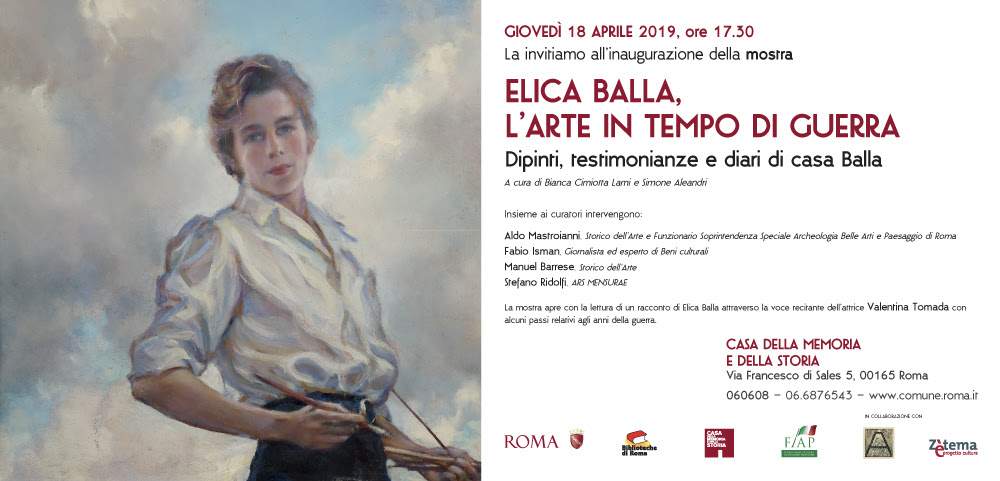Life and works of Elica Balla at the House of Memory and History in Rome
At the House of Memory and History in Rome from April 18 to May 16, 2019, the exhibition Elica Balla, Art in Wartime recounts the family life and artistic activity of the Balla household through the paintings, testimonies and writings of Elica (Rome, 1914 - 1995), the younger of the two daughters of Giacomo Balla, the great Futurist painter. The exhibition moves along a historical track that touches on significant episodes of World War II by bearing witness to them with both literary documentation and a number of works by Elica and Luce Balla.
Elica, who was born in 1914 and died in 1993, was the author of a valuable biographical book Con Balla, published in three volumes by Multhipla Edizioni between 1984 and 1986. From this diary of daily life were taken the excerpts that accompany the substantial iconographic core of paintings and pastel drawings relating to the war years, as well as some works devoted to post-war reconstruction.
In her memoirs, Elica recounts episodes related to the time of the Nazi occupation of Rome, such as that of March 23, 1944, when the young artist was only a few blocks away from Via Rasella where the bomb that struck the convoy of the German occupation forces exploded. From the enjoyment of Elica Balla’s works and accounts, one gets the impression that the beautiful and talented daughter of the futurist master had a limpid and airy sensibility and approach to life, similar to the subject she loved to paint more than any other, the sky.
These character traits prompted her in that terrible 1944 to record, alongside the crude and inevitable testimonies of atrocities, also the ironic and downplaying spirit with which the Roman people managed to joke about the war events. The works in the exhibition are accompanied by memoirs, testimonies and diary pages, transcribed on special media.
One cannot talk about Elica without mentioning Balla’s house and the colorful environment that the great futurist’s home-studio represented. During the war years, the two daughters, while not renouncing outdoor painting, devoted themselves to a constant and intimate work of mutual portraits and self-portraits. A special space has been dedicated to these works: the exhibition is enriched by the desk and chair used by the two sisters, made from fruit crates assembled and painted in leopard spots, according to the colonial taste of the time.
Also on display will be a mysterious painting in the back of which, an example of the well-known pictures painted on the reverse side, emerges a painting covered with a layer of red paint on which Helix inscribed the signature and date of the work painted on the opposite side. The mysterious painting, depicting a man typing with a curious play of overlapping fingers, was partially revealed during restoration and is visible on both sides thanks to a special structure. The work, which has not yet been studied by specialists in the field, at the current state of knowledge is of uncertain attribution, considering that Balla’s home studio was frequented and visited by a multitude of artists.
This affair motivated the curators of the exhibition to illustrate, through images and related explanations, the scientific work that allowed the discovery of the unexpected painting and the removal of the pictorial film that concealed its existence and now restores, through careful cleaning work, its visibility.
Together with the curators Bianca Cimiotta Lami and Simone Aleandri, speakers include Aldo Mastroianni, Art Historian - Soprintendenza Speciale Archeologia Belle Arti e Paesaggio di Roma, Fabio Isman, Journalist and Cultural Heritage expert, Manuel Barrese, Art Historian, Stefano Ridolfi, Ars Mensurae: Non-invasive scientific investigations using innovative portable instruments.
The exhibition will be inaugurated on April 18 at 5:30 p.m. with the reading of selected passages from Elica Balla’s memoirs related to the war years, through the reciting voice of actress Valentina Tomada.
Admission is free.
For all information you can call +39 060608 or visit www.comune.roma.it.
Pictured: a work by Elica Balla
Source: press release
 |
| Life and works of Elica Balla at the House of Memory and History in Rome |
Warning: the translation into English of the original Italian article was created using automatic tools. We undertake to review all articles, but we do not guarantee the total absence of inaccuracies in the translation due to the program. You can find the original by clicking on the ITA button. If you find any mistake,please contact us.





























